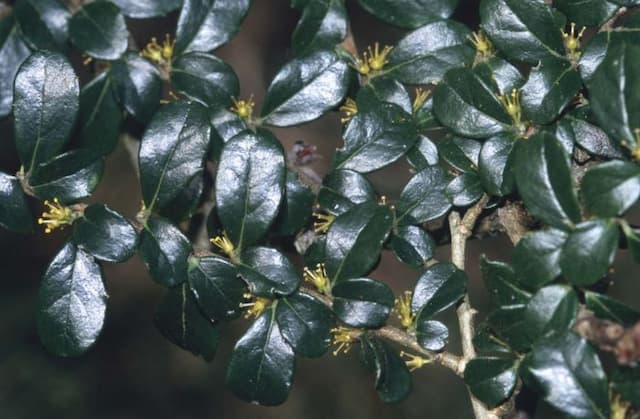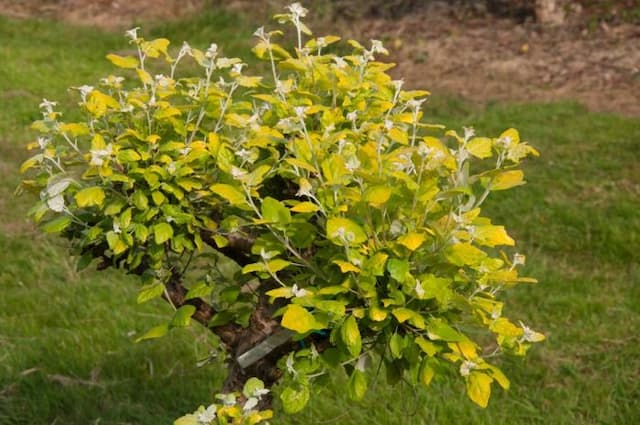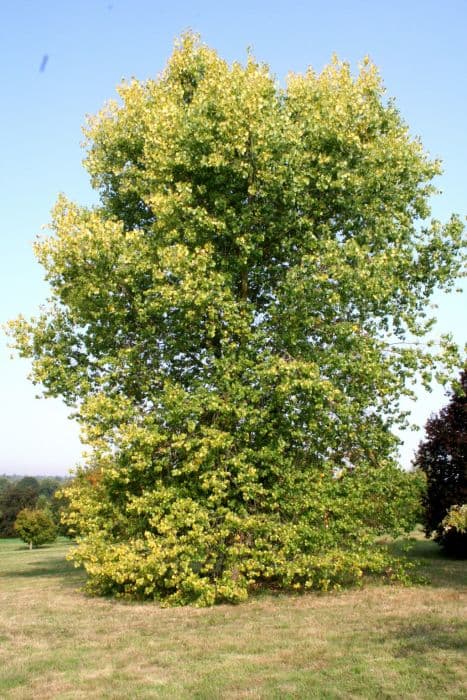Salix alba var. vitellina 'Yelverton'

ABOUT
The plant in question, commonly known as 'Yelverton' willow, is a distinctive variety primarily recognized for its showy stem coloration and foliage. During the winter months, this plant's most striking feature is its stems, which display a bright yellow hue, adding a pop of color to the otherwise dormant landscape. As the seasons turn, the willow produces narrow, elongated leaves that exhibit a light green color. The leaves are typically pointed at the end, giving them a sleek and graceful appearance which complements the overall weeping habit of the branches. The texture of the foliage is finely toothed along the edges, which may provide a subtle textural element to the plant's profile. As with many willows, the 'Yelverton' variant develops catkins, which are cylindrical, flower-bearing structures that add further interest to the plant during the blooming season. These catkins emerge in early spring, often displaying a silvery to yellowish color before the leaves fully unfurl. Overall, the 'Yelverton' willow is appreciated for its year-round visual interest, from the brightly colored winter stems to the delicate spring catkins and vibrant green summer leaves.
About this plant
 Names
NamesFamily
Salicaceae
Synonyms
Golden Willow, Yellow Willow, Yelverton Willow
Common names
Salix alba var. vitellina 'Yelverton'
 Toxicity
ToxicityTo humans
The common name for Salix alba var. vitellina 'Yelverton' is White Willow. Generally, the White Willow is not considered highly toxic to humans. However, as it contains salicin, which is chemically similar to aspirin, ingestion in large quantities could potentially lead to side effects similar to those of aspirin overdose. These symptoms might include stomach pain, ulcers, nausea, vomiting, ringing in the ears, and in severe cases, kidney impairment, and respiratory issues. Salicin sensitivity may also affect individuals with allergies to aspirin. It is generally advisable to avoid consuming any part of ornamental plants not intended for human consumption.
To pets
The common name for Salix alba var. vitellina 'Yelverton' is White Willow. White Willow is not usually considered highly toxic to pets, but as with humans, the presence of salicin can cause issues if ingested in large quantities. In pets, symptoms may include vomiting, diarrhea, and digestive upset. For pets sensitive to salicylates or those with pre-existing conditions, more severe symptoms such as gastrointestinal bleeding or ulceration may occur. As a precaution, it is advisable to prevent pets from ingesting any parts of this plant.
 Characteristics
CharacteristicsLife cycle
Perennials
Foliage type
Deciduous
Color of leaves
Green
Height
50 feet (15 meters)
Spread
20 feet (6 meters)
Plant type
Tree
Hardiness zones
4
Native area
Europe
Benefits
 General Benefits
General Benefits- Ornamental Value: Adds visual interest to gardens with its bright yellow stems, especially striking in winter.
- Wildlife Habitat: Provides shelter and nesting sites for birds, and supports a variety of wildlife.
- Erosion Control: Has an extensive root system that helps to stabilize soil and prevent erosion near water bodies.
- Riverbank Stabilization: Often planted near rivers to protect banks against the eroding effects of flowing water.
- Windbreak: Can be used in hedges or as shelterbelts to reduce wind speed and protect against soil erosion.
- Carbon Sequestration: Like all trees, it absorbs carbon dioxide, thus contributing to the mitigation of climate change.
- Low Maintenance: Generally requires minimal care once established and can tolerate a range of soil conditions.
- Fast Growth: Can quickly reach maturity, making it an excellent choice for new gardens or restoration projects.
- Flexible Usage: Suitable for coppicing and pollarding, traditional forms of woodland management.
- Seasonal Interest: Provides year-round interest with different leaf, stem, and flower textures throughout the seasons.
- Shade Provider: Can grow to a substantial size, offering ample shade in garden spaces or along streets.
- Habitat Diversity: Contributes to the structural diversity of plantings, benefiting overall ecological balance.
 Medical Properties
Medical Properties- Anti-inflammatory: Salix alba var. vitellina 'Yelverton', commonly known as the White Willow, contains salicin which when metabolized in the body becomes salicylic acid, providing anti-inflammatory properties.
- Analgesic: Salicin from the White Willow bark acts as a pain reliever.
- Antipyretic: White Willow has been used to help reduce fevers due to its salicin content.
- Antirheumatic: The plant's extracts are used to alleviate symptoms of rheumatism.
 Air-purifying Qualities
Air-purifying QualitiesThis plant is not specifically known for air purifying qualities.
 Other Uses
Other Uses- Willow sculptures: The flexible and strong branches of the Golden Willow are often used in the creation of living plant sculptures and garden artwork.
- Fodder for animals: The leaves of the Golden Willow can be used as fodder for livestock, particularly in times of scarcity.
- Basketry: The pliable branches make excellent material for weaving baskets and other crafted items.
- Noise reduction: Golden Willow can be planted as a sound buffer to reduce traffic or other environmental noise.
- Bank stabilization: Planting Golden Willow can help stabilize stream banks and prevent erosion due to its extensive root system.
- Windbreaks: Tall specimens can be used as windbreaks to protect crops and soil from wind erosion.
- Charcoal production: The wood of Golden Willow can be used in charcoal making, providing fuel for various uses.
- Dying fabric: The bark contains tannins and can be used for dying fabric naturally.
- Erosion control mats: Branches can be woven into mats that are used to prevent soil erosion on slopes and riverbanks.
- Bioengineering: Golden Willow can be used in bioengineering projects for ecological restoration and habitat creation because of its easy rooting capability.
Interesting Facts
 Feng Shui
Feng ShuiThe Yellow Willow is not used in Feng Shui practice.
 Zodiac Sign Compitability
Zodiac Sign CompitabilityThe Yellow Willow is not used in astrology practice.
 Plant Symbolism
Plant Symbolism- Flexibility: The willow tree, which Salix alba var. vitellina 'Yelverton' is a cultivar of, is known for its flexible branches, symbolizing adaptability and resilience.
- Grief and Mourning: Traditionally, willows have been associated with sorrow and mourning, used as a metaphor for those experiencing loss due to their drooping branches.
- Healing: Willows have medicinal properties; the bark, in particular, contains salicin, a precursor to aspirin, which conveys the symbolic meaning of healing and relief from pain.
- Renewal: Willows can grow new trees from a single fallen branch, symbolizing new beginnings, growth, and regeneration.
 Water
WaterThe Golden Willow requires regular watering, especially during the first growing season to establish a deep, extensive root system. Water it deeply, rather than frequently, to encourage root growth. Depending on the climate and soil conditions, watering once a week with approximately 1.5 to 2.5 gallons of water should suffice. During dry spells or in hot summer weather, you may need to increase the frequency to twice a week. Adjust the amount of water and frequency depending on rainfall and temperature, ensuring the soil remains moist but not waterlogged.
 Light
LightGolden Willow thrives best in full sunlight to partial shade. It prefers a spot that receives at least 6 hours of direct sunlight daily but can tolerate some light shade. Avoid deep shade locations, as this can result in reduced vigor and fewer leaves. An open area that allows for plenty of sunlight throughout the day is ideal for the Golden Willow to grow.
 Temperature
TemperatureGolden Willows are hardy and can tolerate a wide range of temperatures, typically from -30°F to 100°F, making them suitable for various climates. However, the ideal temperature range for this willow is between 50°F and 75°F. It is important to protect the tree from extreme cold when it is young, but once established, it can handle low temperatures well.
 Pruning
PruningGolden Willow benefits from pruning to maintain shape, promote vigorous growth, and remove dead or damaged branches. Prune in late winter or early spring before new growth starts, as this is when the tree is dormant. Remove unwanted branches, thin out dense areas to allow sunlight to penetrate, and cut back growth as needed to shape the tree or shrub form. The Golden Willow can be pruned annually, but extensive pruning should be done every few years.
 Cleaning
CleaningAs needed
 Soil
SoilGolden Willow thrives in well-draining, moist soil rich in organic matter. A mixture of loamy soil, compost, and peat works well, maintaining a pH between 6.0 and 7.5.
 Repotting
RepottingGolden Willows, typically grown outdoors, do not require repotting. In landscape settings, they should be planted in a location that can accommodate their growth without the need for transplanting.
 Humidity & Misting
Humidity & MistingGolden Willow prefers outdoor conditions with natural humidity and does not require specific humidity levels when planted in its ideal environment.
 Suitable locations
Suitable locationsIndoor
Golden Willow not ideal for indoor growth; too large.
Outdoor
Plant in moist, well-drained soil; full sun exposure.
Hardiness zone
Golden Willow is hardy in USDA zones 2-8.
 Life cycle
Life cycleSalix alba var. vitellina 'Yelverton', commonly known as the golden willow, starts its life cycle from seeds which germinate in moist soil conditions in spring. Seedlings quickly establish a root system and begin to produce slender stems and foliage. As a fast-growing tree, it enters a rapid vegetative growth phase, during which it can grow several feet in a single season, developing a characteristic yellow bark and elongated leaves. The golden willow reaches maturity within a few years, at which point it can produce catkins in early spring before the leaves emerge; these catkins are crucial for pollination and subsequent seed production. In the reproductive stage, pollinated catkins develop into capsules that release seeds, starting the cycle anew. The tree then enters a period of senescence which can be many years, after which it declines in vigor and may eventually die, often providing habitat for various wildlife even as it decomposes.
 Propogation
PropogationPropogation time
Spring
The most popular method for propagating Salix alba var. vitellina 'Yelverton', commonly known as Golden Willow, is by using cuttings. This is often done in late winter or early spring before the willow begins to leaf out. Cuttings should be taken from healthy, vigorous, one-year-old wood. A typical cutting might be about 9 to 12 inches (approximately 23 to 30 centimeters) long, and all but the top few buds should be removed. These cuttings are then placed directly in moist soil or alternatively, they can be rooted in water, where they will quickly develop roots. Once rooted, the cuttings can be transplanted to their final location, where they will grow into new trees, providing the same ornamental value and vigor as the parent plant.









